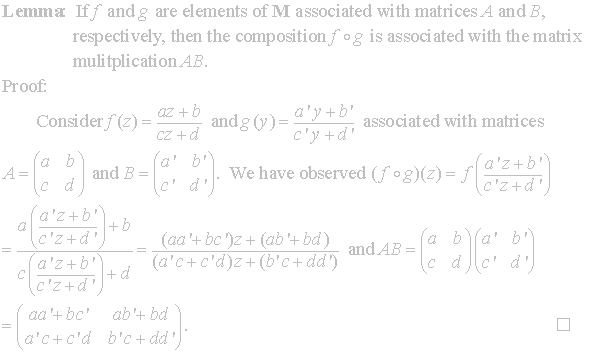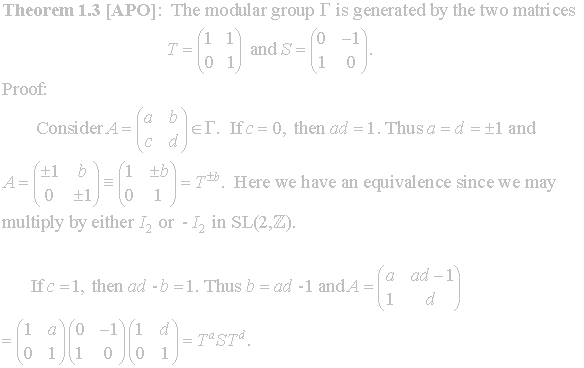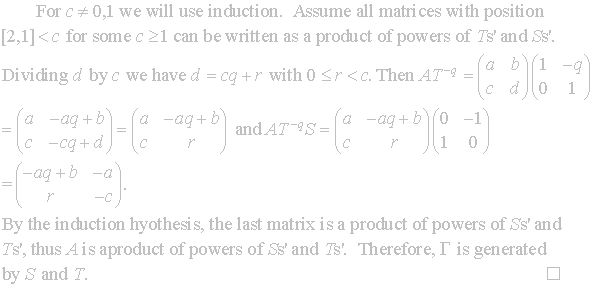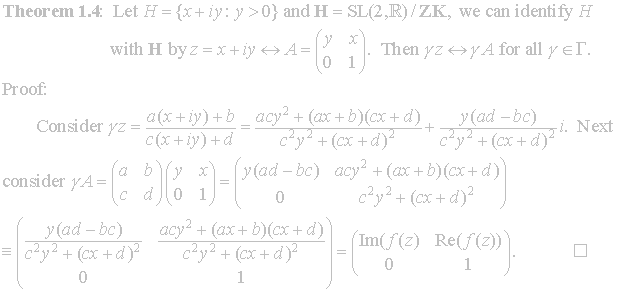|
|
|
1. Classical Möbius Transformations:
We
begin our look at
![]() by the classical method of
examining Möbius transformations. It
is due to our familiarity of these transformations and their action on the upper
half-plane that allow us to progress into the cleaner matrix form and
by the classical method of
examining Möbius transformations. It
is due to our familiarity of these transformations and their action on the upper
half-plane that allow us to progress into the cleaner matrix form and
![]() .
.

Multiplying all coefficients a,b,c,d by a nonzero constant does not change a Möbius transformation, thus there is no loss of generality in assuming that ad - bc = 1
Next we note how Möbius transformations are related to matrices. Given a


![]()
So
composition of functions is associated with matrix multiplication and thus is
associative over M. The
identity matrix
 is associated with the identity
transformation
is associated with the identity
transformation
![]() . Similarly the matrix inverse
. Similarly the matrix inverse
 is associated to the inverse of f,
is associated to the inverse of f,
![]() . Therefore we have proven the
following theorem.
. Therefore we have proven the
following theorem.
Theorem
1.1: The set of Möbius Transformations M form a group under
composition.
Now
that we have associated matrices with the group of Möbius transformations, we
will define our matrix group
![]() .
.

Next
we shall consider
![]() by
by
 . Clearly f is injective and
surjective, and we have seen group operations hold, thus f is an
isomorphic function and
. Clearly f is injective and
surjective, and we have seen group operations hold, thus f is an
isomorphic function and
![]() . Thus proving the next theorem.
. Thus proving the next theorem.
![]()
Consequently
Γ acts on the upper half-plane in the same way as a Möbius transformation.
So we define the action for
 .
.
We
now abandon the familiar Möbius transformations for the cleaner form of
matrices as we continue to develop notation to present fundamental regions. We will show that Γ is generated by two elements, thus
we will only need to consider their action on the upper half-plane as we present
an algorithm to find a matrix to map any point in the upper half-plane into that
region.


It
will become more obvious later how T and S act upon points of the
upper half-plane, however we will quickly note their action here.
![]() is a
shift of ‘n’ units along the real axis:
is a
shift of ‘n’ units along the real axis:  ;
and S is a negative inversion:
;
and S is a negative inversion:  .
.
We
also note that the inverse of S is itself and the inverse of ![]() is
is
![]() . We
now turn our attention toward identifying
. We
now turn our attention toward identifying
![]() with
the upper half-plane. First we will need to recall some familiar definitions.
with
the upper half-plane. First we will need to recall some familiar definitions.

 where
where
 is a
subgroup of
is a
subgroup of

We
will refer to this form as the canonical form since we will, in the next
theorem, identify the associated coordinates in the upper half-plane with this
matrix form. We
will often return to this canonical form during calculations.

Now
that we have
![]() identified
with the upper half-plane we proceed to a fundamental region and explore how
identified
with the upper half-plane we proceed to a fundamental region and explore how
![]() acts on
the upper half-plane.
acts on
the upper half-plane.